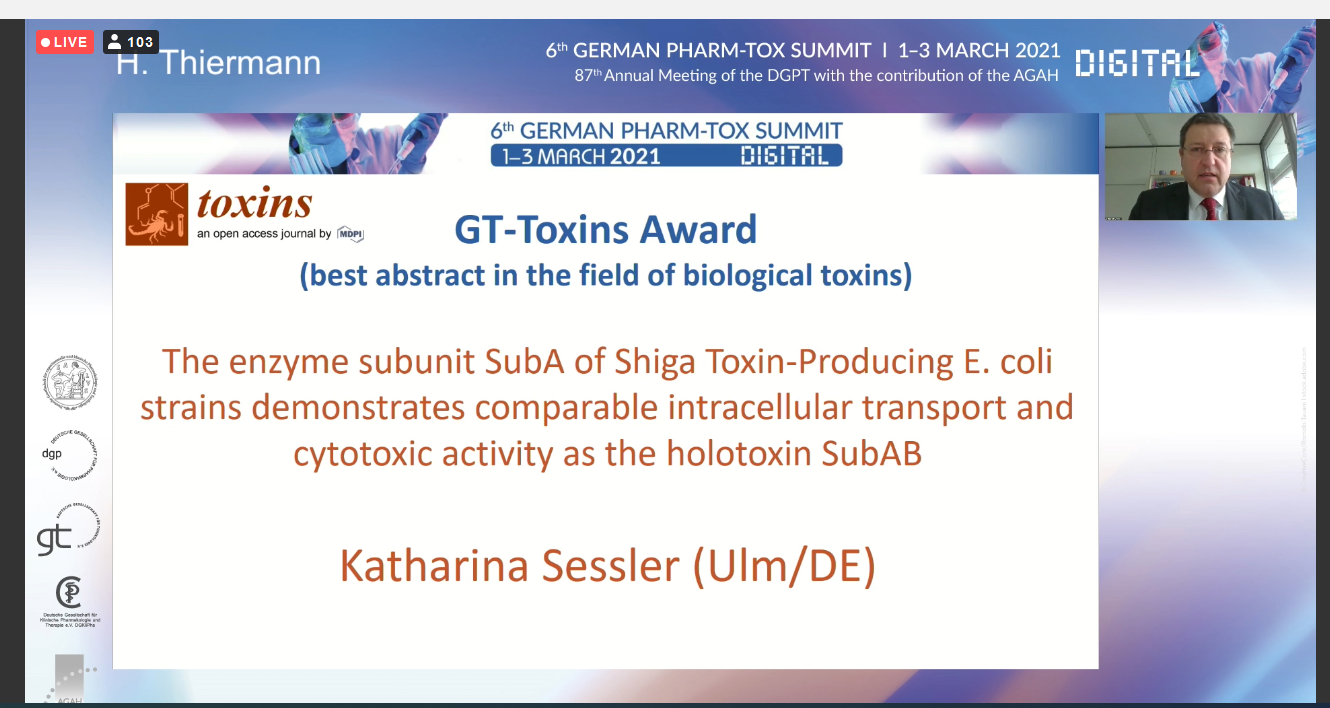17 March 2021
Toxins | Congratulations to GT-Toxins Award Winner at the 6th German Pharm-Tox Summit, Digital, 2021
You are accessing a machine-readable page. In order to be human-readable, please install an RSS reader.
All articles published by MDPI are made immediately available worldwide under an open access license. No special permission is required to reuse all or part of the article published by MDPI, including figures and tables. For articles published under an open access Creative Common CC BY license, any part of the article may be reused without permission provided that the original article is clearly cited. For more information, please refer to https://www.mdpi.com/openaccess.
Feature papers represent the most advanced research with significant potential for high impact in the field. A Feature Paper should be a substantial original Article that involves several techniques or approaches, provides an outlook for future research directions and describes possible research applications.
Feature papers are submitted upon individual invitation or recommendation by the scientific editors and must receive positive feedback from the reviewers.
Editor’s Choice articles are based on recommendations by the scientific editors of MDPI journals from around the world. Editors select a small number of articles recently published in the journal that they believe will be particularly interesting to readers, or important in the respective research area. The aim is to provide a snapshot of some of the most exciting work published in the various research areas of the journal.
Original Submission Date Received: .
The Editorial Team of Toxins would like to congratulate the winner of the GT-Toxins Award, Katharina Sessler, at the 6th German Pharm-Tox Summit.

Here is the title and abstract of her work:
The Enzyme Subunit SubA of Shiga Toxin-Producing E. coli Strains Demonstrates Comparable Intracellular Transport and Cytotoxic Activity as the Holotoxin SubAB
K. Sessler 1, P. Papatheodorou 1, F. Wondany 2, M. Krause 3, S. Noettger 1, D. Bernhard 3, J. Michaelis 2, H. Schmidt 3, H. Barth 11 University Ulm Medical Center, Institute of Pharmacology and Toxicology, Ulm, Germany
2 University Ulm, Institute of Biophysics, Ulm, Germany
3 University of Hohenheim, Institute of Food Science and Biotechnology, Hohenheim, Germany
Shiga toxin-producing Escherichia coli (STEC) strains are bacterial pathogens, which are mainly found in the gastrointestinal tract of farm and wildlife animals. The bacteria can be transmitted to humans via food and causes diarrheal and extraintestinal diseases. In addition to the Shiga toxin, some STEC strains also produce a second toxin, namely the subtilase cytotoxin (SubAB) [1]. SubAB belongs to the family of AB5 toxins, consisting of an enzymatically active A subunit (SubA) and separate B subunits (SubB), which mediate cell binding and uptake of SubAB. Inside the host cell, SubAB is transported via a retrograde pathway into the endoplasmic reticulum (ER), where it cleaves the glucose-regulated protein GRP78. SubAB-induced GRP78 cleavage activates a cellular stress response eventually resulting in cell death [1]. We previously demonstrated that SubA, without SubB, binds and intoxicates HeLa cells [2], whereas the cellular and molecular mechanisms behind this remained unclear. In the present study, we found that even in the absence of SubB, SubA is internalized into cells, reaches the endoplasmic reticulum (ER) and cleaves the chaperone GRP78. Furthermore, SubA-induced GRP78 cleavage in cells is prevented by the pre-treatment of cells with brefeldin A (BFA), which inhibits the transport of protein toxins into the ER. Obviously, SubA contains a yet undescribed ER localization signal, predicted by the software scanProsite™ as a SEEL motif at the C-terminus. Hence, a SubA mutant, lacking the SEEL motif (SubAΔC344), was generated, which exhibited no cytotoxicity alone, but only together with SubB, when tested on HeLa and HCT116 cells. Fluorescence microscopy revealed that SubAΔC344 is generally taken up into cells, but further investigations regarding substrate cleavage have shown that SubAΔC344-induced GRP78 cleavage was delayed when compared to wildtype SubA. We therefore assume that the SEEL motif plays a crucial role in guiding SubA into the ER [3]. Furthermore, we confirmed our findings in the human intestinal mini-gut organoid system. Our results not only contribute to a better understanding of the mode of action of the subtilase cytotoxin, but also raise the question whether a B component-independent cytotoxic effect of the A component is also true for other bacterial AB5 toxins.
